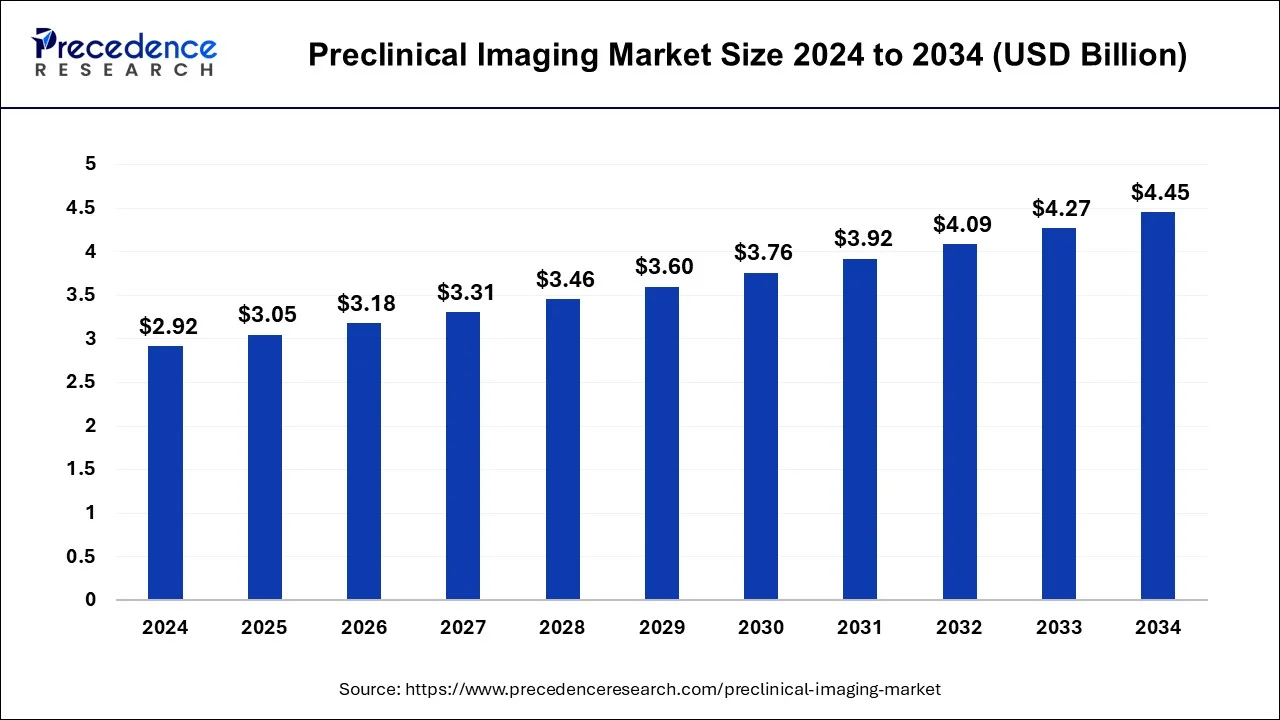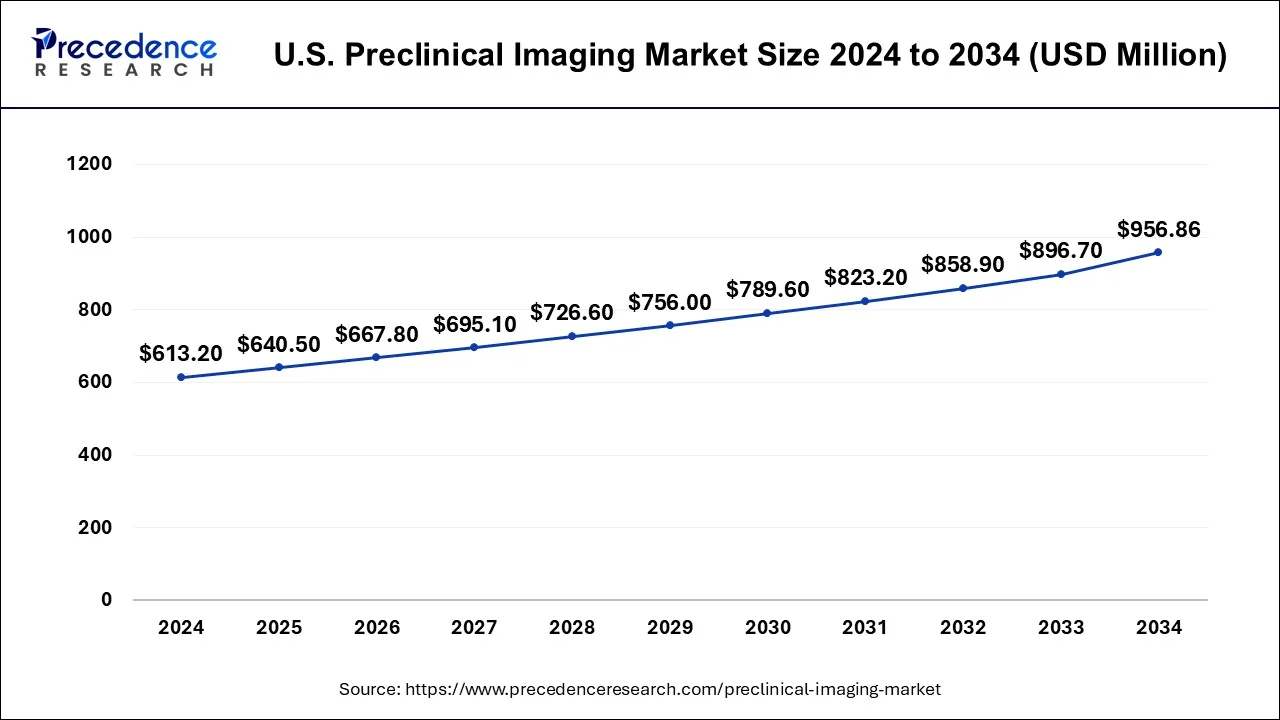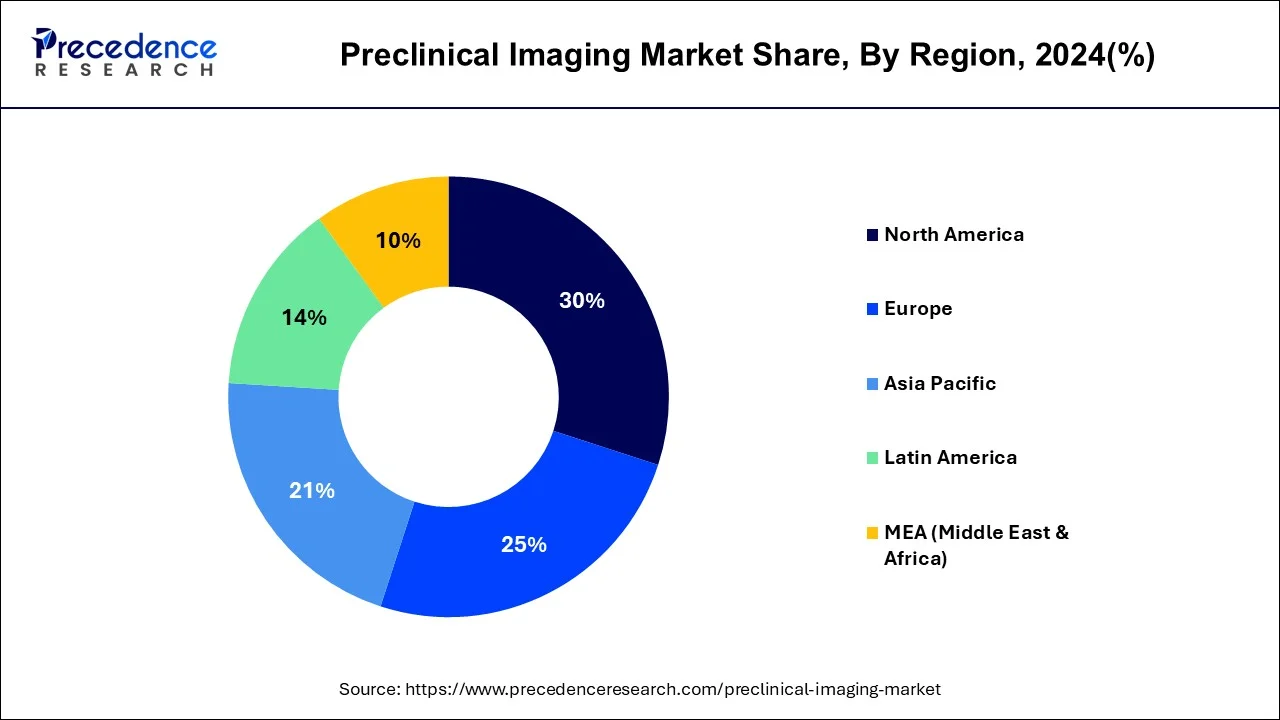January 2025
The global preclinical imaging market size is calculated at USD 3.05 billion in 2025 and is forecasted to reach around USD 4.45 billion by 2034, accelerating at a CAGR of 4.30% from 2025 to 2034. The North America preclinical imaging market size surpassed USD 880 million in 2024 and is expanding at a CAGR of 4.32% during the forecast period. The market sizing and forecasts are revenue-based (USD Million/Billion), with 2024 as the base year.
The global preclinical imaging market size accounted for USD 2.92 billion in 2024, grew to USD 3.05 billion in 2025 and is projected to surpass around USD 4.45 billion by 2034, representing a healthy CAGR of 4.30% between 2024 and 2034. The market is growing due to increased demand for drug development derived from technological advancements, rising research investments, growing Clinical Research Organizations (CRO) expansions, research infrastructure, and multimodal imaging.

The U.S. preclinical imaging market size accounted for USD 613.20 million in 2024 and is expected to be worth around USD 956.86 million by 2034, growing at a CAGR of 4.55% between 2025 and 2034.

Maximum revenue was generated through the North American region in the past and there are many factors that support the growth of this market in the North American region. The research infrastructure in the North American region is extremely developed which proves to be a major growth factor. The skilled professionals available in the North American region plays a significant role in the growth of the market. The number of preclinical initiatives taken by the organizations or the projects that are in progress or large in number. The use of technologically advanced equipment is more in the North American region due to which quality products can be obtained. A large number of initiatives are taken by the government in various regions of the North American area which are extremely supportive of the development and research activities for all the projects in the region.

The research and development activities receive a boost in the nations like Canada especially due to the introduction of the programs like tax credits. as the regulatory guidelines are favorable and the cost of research is less in the Asia Pacific region the market growth will be good. These factors will bring more opportunities in the Asia Pacific region for Preclinical Research. The outsourcing industry in clinical research is also growing in developing nations of the world like India and China.
The preclinical imaging market is in reference to the living animal vision which helps in analysis. Imaging modes as well as drug development are extremely important for researchers. The number of funds received all various organizations for research purpose have increased in recent years and these are extremely supportive of Preclinical Research. As the market demand for preclinical imaging has also increased in recent years the market will show significant growth.
The existing market players will lead to the introduction of innovative technologies for molecular imaging and it will also receive a large amount of funding from various organizations and this will lead to the growth of the market during the forecast period. Technological advancements will also play a significant role in the growth of the market as it has led to the introduction of hybrid systems for imaging.
Preclinical Research is extremely important in transforming the performance of modern medicines and how these medicines are delivered in order to treat and resolve the problems that patients face. As clinical research organizations are also increasing in number the market is expected to grow well. There are many other factors that will help the growth of the market like the policies or the rights that protect the animals due to which the use of these animals for testing will be reduced. The availability of alternative methods in the market like that of computer-based models and micro-dosing is growing rapidly.
Most of the market players are engaged in research and development activities in order to enhance the existing products in the market. These companies are also focused on making investments to launch new products. These are the most important strategies adopted by organizations. The number of partnerships, collaborations, and agreements has also increased in recent years which has led to the introduction and enhancement of better technologies. In order to strengthen the product portfolio, the companies are constantly focusing on expanding their presence in various geographical locations.
The government support received by companies in developing nations will play a significant role in the growth of the market. Translational activities of research have also grown. The regulatory policies in Asian countries have evolved and they are extremely beneficial for the growth of the market. The adoption of novel imaging technologies at the molecular level has also grown significantly. The increase in the number of biotechnology companies and pharmaceutical companies across the globe will lead to the growth of the market.
The demand for multi-modality systems has also increased which will drive market growth in the coming years. The demand for non-invasive procedures on small animals has also increased significantly. The number of funds received by the organizations and the initiatives taken by the organizations for the Preclinical Research will propel the market growth.
The applications of artificial intelligence in health diagnostics are expected to be revolutionary. AI integrates many advanced algorithms and machine learning capabilities to process medical images more quickly than before, which can save time for the adjusted time diagnosis to make it more accurate. Pattern recognition and anomaly knowledge across large datasets with AI improve diagnosis accuracy for most diagnoses avoided. It can also serve as a diagnostic prediction to allow early disease detection for better patient outcomes in situations like cancer.
In addition, AI has a core role in personalized medicine, providing tailored results based on the patient's characteristics and medical history. Nevertheless, AI in diagnostic imaging will face challenges of privacy in data use, the risk of bias in algorithms, and the need for investments in technology and training. There will also be a requirement for sound guidelines and ethical parameters to enforce.
| Report Coverage | Details |
| Market Size by 2034 | USD 4.45 Billion |
| Market Size by 2025 | USD 2.92 Billion |
| Market Size in 2024 | USD 3.05 Billion |
| Market Growth Rate from 2025 to 2034 | CAGR of 4.30% |
| Leading Region | North America |
| Base Year | 2024 |
| Forecast Period | 2025 to 2034 |
| Segments Covered | Product, End User, and Regions |
| Regions Covered | North America, Europe, Asia-Pacific, Latin America, and Middle East & Africa |
Technological Advancements
Medical imaging is now transforming rapidly because of new technological and methodological innovations. Hybrid imaging modalities like PET/CT, PET/MRI, and SPECT/CT provide for the integral anatomy and function in precise disease detection and monitoring of treatment. Artificial intelligence and machine learning made a revolutionized change in image analysis, enhancing the quality of images and preserving early diagnosis. The Checklist for Artificial Intelligence in Medical Imaging (CLAIM) is being updated to define elements for popular reporting of artificial intelligence advances. Molecular probes and radiopharmaceuticals have broadened the horizon for nuclear imaging techniques, MRI technology has updated on the spatial-temporal resolution and the 3D printings of organs from MRI and CT scans allow precise surgical planning along with personalized treatment strategies.
The optical imaging devices segment is expected to have the largest share in the market in the coming years period as a large number of small animals are used in the imaging for the discovery of drugs the market is expected to grow well. The segment of multimodal imaging devices is also expected to show significant growth in the coming years period technological advancements will play a significant role in the growth of the market as it will lead to an introduction of integrated systems like anatomical digital imaging systems and molecular digital imaging systems. these systems help in multiple screenings of a single unit. These are the devices of the new generation that have integrated the technology of imaging and this shall provide maximum growth opportunities in the coming years period the segment of the reagents will also continue to grow in the coming years. Increased digitalization in the field has provided an interface that is user-friendly and it is finding major application in the field of oncology research.
On the basis of the end user, biotechnology companies are expected to have the highest share of the market during the forecast period. The amount of research and development work carried out in these companies has grown significantly and the amount of investment made for these activities has also grown. The constant need for advanced drugs will create more demand for research and development work. The use of this technology in biotechnology companies is more due to its application. Research institutes and pharmaceutical companies also make use of preclinical imaging techniques to a great extent.
By Product
By End-User
By Geography
For inquiries regarding discounts, bulk purchases, or customization requests, please contact us at sales@precedenceresearch.com
No cookie-cutter, only authentic analysis – take the 1st step to become a Precedence Research client
January 2025
September 2024
January 2025
January 2025